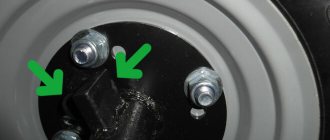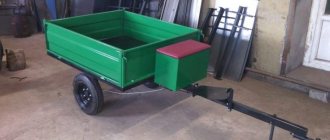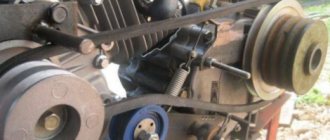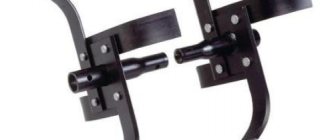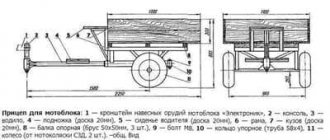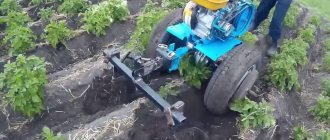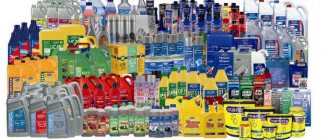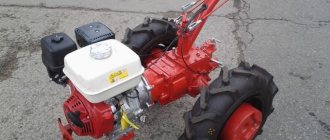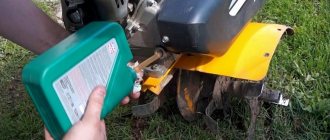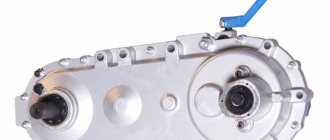Walk-behind tractor favorite gearbox device
STRUCTURE OF THE FAVORITE MOTOR-BLOCK
The motoblock consists of the following main parts and assemblies:
motor 5 with gearbox (Fig. 2); gearbox 9 (Fig. 2); wheels 6 (Fig. 2); 7 scutes (Fig. 2); steering wheel 1 (Fig. 2); clutch lever 11 (Fig. 2); steering rods 2 (Fig. 2); attachment supports 8 (Fig. 2); throttle control lever 3 (Fig. 3); gear lever 5 (Fig. 3); steering wheel supports 3 (Fig. 2); steering wheel fixing handles 2 and 4 (Fig. 3); pulley casing 4 (Fig. 2); engine belt casing 1 (Fig. 3).
Rice. 2. Motoblock Favorite (left ¾ view). 1 — steering wheel; 2 — rod; 3 – steering wheel support; 4 – pulley casing; 5 – motor with gearbox; 6 – wheel; 7 – shield; 8 – attachment support; 9 – walk-behind tractor gearbox; 10 – oil filler plug; 11 – clutch lever.
Rice. 3. Motoblock Favorite (right view). 1 – engine pulley casing; 2 – handle for fixing the steering wheel in the horizontal plane; 3 – engine throttle control lever; 4 – handle for fixing the steering wheel in a vertical plane; 5 – gear shift lever. places where the walk-behind tractor is moored (for transferring or lifting).
Rice. 4. Motoblock Favorit with rotors for cultivation. 1 – king pin; 2 – opener; 3 – quick-release cotter pin; 4 – axis; 5 – opener holder; 6 – axis; 7 – universal hitch; 8 – oil outlet of the gearbox; 9 – short rotor bushing; 10 – left knife; 11 – long rotor bushing; 12 – rotor disk; 13 – right knife.
Source
INTRODUCTION
The Favorite walk-behind tractor, models MB-2, MB-3, MB-4 and MB-5 and their modifications, is a universal, multifunctional petrol unit designed for agricultural work carried out in collective gardens, personal plots and personal subsidiary plots.
Walk-behind tractor models differ in the engines installed on them from the following companies - (Italy), HONDA (Japan), LIFAN (China), BRIGGS & STRATTON (USA) with high technical and economic indicators. The technical data of the engine are described in the walk-behind tractor's passport, and how to operate it correctly - in the engine operating manual attached to each walk-behind tractor.
With the help of attachments, the walk-behind tractor performs the following operations: cultivate, plow the ground, hill up, mow grass, supply water, carry out snow removal.
This operating brochure describes how to properly use the Favorit walk-behind tractor as a cultivator and the rules for caring for it after use. How to use other attachments and units (see section 11) is subject to specific requirements specified in the manuals for the relevant units.
Working with a walk-behind tractor is not difficult, but using it and adding various attachments requires some skill.
The walk-behind tractor will serve you for a long time if you follow the instructions for care, storage, and maintenance of this unit set out in the manual.
The steering wheel with controls has the function of adjusting the height and angle of rotation for ease of use.
Models and designs of walk-behind tractors are constantly changing and improving, so some details may differ from those set out in the manual.
Marking.
The marking of the walk-behind tractor is applied to a metal plate located on the steering wheel support and contains:
- manufacturer's trademark;
- mark of conformity of a certified product;
- product name;
- walk-behind tractor model
- number of technical conditions;
- product version;
- serial production number of the product;
- Year of manufacture;
- weight of the product.
Attention - symbols.
ATTENTION! On some walk-behind tractor panels there are symbols that carry warning information:
Risk of injury or damage to surrounding objects.
Rotating cutters can cause injury. When the cutters are spinning, keep your distance.
Read the instructions before using the walk-behind tractor, especially the requirements in the “Instruction” section.
Make sure there are no children or animals nearby.
Description
Favorite walk-behind tractors are produced at JSC Plant named after.
Degtyarev". This is one of the leading enterprises in Russia for the production of soil cultivation equipment. Its products are distinguished by their build quality, low price (since domestic parts are used) and long service life. In total, there are several modifications in the Favorit line of walk-behind tractors. Let's look at each of them in more detail.
Motoblock Favorit MB 1
This is a representative of the light class of walk-behind tractors. Its weight is only 67 kg.
Motoblock Favorit MB 1
The Favorite 1 walk-behind tractor is equipped with a ZiD gasoline engine with a capacity of 7 horsepower.
Fuel consumption on average is 1.3 liters per hour of operation.
The gearbox has 3 positions: 2 for driving forward and one for moving backward.
The ZiD 1 walk-behind tractor is designed for cultivating soft soils and caring for agricultural crops.
Motoblock Favorite MB 3
This is also a lightweight walk-behind tractor, but more advanced.
This device is equipped with a Briggs&Stratton INTEK 6.5HP gasoline engine.
Motoblock Favorite MB 3
The weight of the Favorite 3 walk-behind tractor is 73 kg.
There are 6 speeds (4 forward, 2 reverse).
Fuel consumption is similar to Favorit 1 – 1.3 liters per hour of intensive work.
Motoblock Favorite MB 4
This model is equipped with a Lifan four-stroke gasoline engine, which is similar to the Honda GX-220.
The weight of the Favorite MB 4 walk-behind tractor is 73 kg.
Motoblock Favorite MB 4
The gearbox has 6 speeds (4 forward and 2 reverse).
Fuel consumption is 1.5 liters per hour of operation.
Motoblock Favorit MB 5
This machine comes with axle shafts of different diameters.
In order to achieve optimal speed, a gearbox is used, which works with a belt drive in a gentle mode.
Motoblock Favorit MB 5
Large pneumatic wheels allow you to move on any surface.
Ground clearance is 15 cm.
Walk-behind tractors Favorite MB 5 are produced with several engines: ZiD (7.0 hp), Subaru Robin - EX21 (7 hp), Honda - GX160 (5.5 hp), Briggs&Stratton - Vanguard 6HP (6 hp). With.).
TECHNICAL DATA OF MOTOR-BLOCK FAVORITE models MB-2, MB-3, MB-4, MB-5 and its modifications.
Dimensions and parameters.
| Length, mm, no more | 1700 |
| Width, mm, no more | 650 |
| Height (excluding steering wheel height adjustment), mm, no more, track (adjustable), mm | 135 |
| smallest | 470 |
| greatest | 670 |
| Weight, kg, no more (without fuel and accessories) | 73 |
| Wheel tires | 4.00-10 model F-106 GOST 7463-89 or 4.5-10 model 604V TU 38.05.01.057-02, or model 4.00-10 6PR with camera 4.00-10 6 PR TR13, made in China |
| Air pressure in tires MPa (kg/cm²) of walk-behind tractor: | 0.1. 0.15 (1. 1.5) Number of gears |
| Forward | 2 |
| Back | 1 |
The speed of the walk-behind tractor.
By rearranging the pulleys in the V-belt drive installed on the engine gearbox and the walk-behind tractor gearbox (see Section 7.4), the speed of movement in each gear is changed (*).
Power transmission.
| motor reducer | 2-shaft gear |
| engine gear ratio | 2,27 |
| walk-behind tractor gearbox Belt type B(B)-850 IV GOST 1284.2-89 | 6-shaft, with pulley |
Filling oil type.
| for gearbox in walk-behind tractor | TAP-15V, or TAD-17I, or MS-20 |
| for gearbox in engine | motor oil SAE 10W-30 API SF or SG |
Filling oil type.
Data on filling fuel and oil into the engine are set out in the engine operating manual.
Attachments
Motoblocks Favorit have gained great popularity due to the fact that they can perform a huge amount of work using attachments. With low power there is low fuel consumption, but the functionality is much greater than that of a mini tractor.
Milling cutters
The basic attachment for a walk-behind tractor is a milling cutter. It is often sold complete with the Favorit walk-behind tractor. The advantage of ZiD OJSC products is that their width can be adjusted using axle shafts and a set of additional spare parts.
When working near crops, there is a high probability of damaging them. In order to prevent this, protective discs are installed at the end of the cutters.
Milling cutters are installed instead of pneumatic wheels.
Plow
A simpler classic attachment for mixing topsoil is a plow. It was used by people of ancient times.
OJSC "ZiD" offers its classic plow. Its weight is 10 kg. It is designed for an average plowing speed of 2.5-3.5 km/h.
The warranty period is 5 years.
Plow and hitch for the Favorit walk-behind tractor
An improved model is the reversible plow. It has a special shape of a ploughshare, which, before throwing, first turns the earth over several times, and only then throws it to the side.
Plowing occurs as follows: the first rut is made, then one wheel is placed in it, and the plow is lowered into the ground. Thus, the second track buries the first. Thanks to the rotary handle, you can control the Favorit walk-behind tractor while moving from its side and not trample the trench.
Mowers
The lush growth of weeds causes a lot of trouble in cleaning them. Motoblocks Favorit together with a mower can help solve this problem.
KR-3 mower for the Favorit walk-behind tractor
Rotary mower KR-2 for the Favorit walk-behind tractor
ZiD offers the KR-3 rotary mower. It is designed for mowing ordinary grass and rough-stemmed plants in small areas, roadsides, etc. The mower allows you to protect the operator from flying grass and stones thanks to the high protective side.
The height of the grass being grabbed is 3 cm.
The rotor speed is 2570 rpm.
Mowers perform well when making hay for the winter, since all that remains is to collect the dried grass.
Potato digger and potato planter
Potatoes are a very common crop in our country. However, working with it involves a lot of physical labor. Favorit walk-behind tractors along with attachments can help with this.
The potato planter is designed for planting potatoes. The potato planter has the following device: in front there is a plow that breaks the rut, behind there is a tank with a conveyor belt for feeding potato tubers. Two hillers are buried behind the trench.
After the root crops ripen, they need to be collected.
Potato digger KKM-1 Potato planter KSP-02
To dig up potatoes, you can use an ordinary plow, but it has a drawback: it cuts a large number of tubers.
A vibrating potato digger is considered more professional. In front of it there is an active knife, which cuts the layer of earth and feeds it to the screen (steel rods), where the piles of earth are broken, and only fruits remain on the surface. Then the operator can only harvest the crop.
Snow blower and shovel
To clear snow in winter, you can use the Favorit walk-behind tractor together with the SM-2 snow blower from ZiD OJSC.
In front of it there is a pulley for collecting snow, then it falls on the rotor, where it unwinds and is thrown to the side.
The height of the snow cover is 17 cm.
The range of ejection of the bulk of the snow cover by the SM-2 snow blower is 5 m.
The average speed is 2-4 km/h.
The weight of the SM-2 snow blower is about 55 kg.
Motoblock snow blower SM-1 “Favorite” Moto-block snow blower SM-2 Shovel blade
A simpler attachment for snow removal is a shovel blade. This is a sheet of metal curved in an arc and located at an angle, with an active knife installed at the bottom for cutting hard layers of snow.
The overall dimensions of the blade blade are as follows: 495×1000×400 mm.
The rotation angle can be adjusted ±20°.
The average speed of the Favorit walk-behind tractor together with a blade-shovel is 2.5-5 km/h.
Wheels and lugs
Favorit walk-behind tractors come standard with pneumatic wheels of sizes 4.00-10 or 4.5-10. However, due to their low weight, they often slip and slip when receiving increased loads.
Wheels and lugs
Therefore, if it is necessary to increase grip on the ground, it is recommended to use lugs. They are a metal rim with welded herringbone plates.
Caterpillars
When transporting loads in winter, traction is a big problem, since even lugs often do not help. In this case, pneumatic wheels can be replaced with tracks. They increase the contact area of the device with the ground, thereby improving the ride.
When choosing tracks, you need to pay attention to their width. The larger it is, the better the grip on the surface. However, this will make it harder for the engine to power it, since tracks are very heavy equipment.
Weights
Weighting weights
Another way to improve the adhesion of the Favorit walk-behind tractor to the surface of the earth is to give it additional weight using weights. Factory weights are produced in the form of 18 kg pancakes, which are hung on the wheel frame in front of the wheel.
Usually two pancakes are hung. In total, instead of 70 kg, you can get a device weighing 110 kg.
Adapters
When working with the Favorit walk-behind tractor, there is a lot of physical strain on the operator, since he has to move behind it while standing and direct the movement. When performing long-term work, it is recommended to use adapters.
This is a special attachment with a chair, thanks to which you can do work while sitting.
INSTRUCTIONS.
ATTENTION! Carefully study the operating and safety instructions for both the engine and the Favorite walk-behind tractor itself. Carefully read the tips will help you ensure long and trouble-free operation of the walk-behind tractor.
- Learn the purpose and how to properly operate, turn on and off the walk-behind tractor.
- Keep children and friends who have not read the instructions near the unit.
- Clear the work area by removing all unnecessary items that could damage the walk-behind tractor.
- Refuel with the engine stopped, observing fire safety. The canister must comply with the standards
- Check the fuel tank for leaks after refueling.
- Do not make adjustments with the engine running.
- oil and fuel should not come into contact with hot engine parts;
Description of the brand "Favorit"
Motoblocks "Favorit" are a development of the Kovrov plant named after.
A.V. Degtyarev, also known as “ZID”. Until 1949, the plant was called the “Kovrov Machine Gun Plant” and only in 1949 it was renamed in honor of the hero of labor and one of the leaders of the enterprise. For a long time, from the beginning of the 20th century, the plant's specialization was the production of weapons (machine guns, artillery mounts). Later, the production of road motorcycles was added to the production of weapons.
Motorcycles from ZID quickly became popular in the USSR and beyond. Already in 1949, motorcycle production reached 5 thousand units per month. So the plant in the city of Kovrov became even more famous, not only for the production of military equipment, but also for civilian products. Tillage equipment is another area of the plant’s activities.
Motoblocks produced under the Favorit brand are considered one of the best in Russia, as evidenced by reviews from owners. Both cultivators and walk-behind tractors of this brand are included in the list of the most famous and best-selling items from ZID. Since its release, the walk-behind tractor has been repeatedly subjected to changes, improvements in design and characteristics.
The Favorit range of walk-behind tractors includes models with both petrol and diesel engines. These devices are equipped with engines from Honda, Briggs & Stratton, Lifan, Robin Subaru, as well as engines produced by Kovrov - ZID of various brands.
The list of attachments for “Favorites” is also very extensive. In 2013, the plant released new attachments - a disc hiller and a rotary mower. The product successfully passed a test drive in combination with a walk-behind tractor and received positive feedback from the owners.
DEVICE OF MOTOR-BLOCK FAVORITE.
The walk-behind tractor consists of the following main parts and units:
- motor 5 with gearbox (Fig. 2);
- gearbox 9 (Fig. 2);
- wheels 6 (Fig. 2);
- 7 scutes (Fig. 2);
- steering wheel 1 (Fig. 2);
- clutch lever 11 (Fig. 2);
- steering rods 2 (Fig. 2);
- attachment supports 8 (Fig. 2);
- throttle control lever 3 (Fig. 3);
- gear lever 5 (Fig. 3);
- steering wheel supports 3 (Fig. 2);
- steering wheel fixing handles 2 and 4 (Fig. 3);
- pulley casing 4 (Fig. 2);
- engine belt casing 1 (Fig. 3).
Rice. 3. Motoblock Favorite (right view).
1 – engine pulley casing; 2 – handle for fixing the steering wheel in the horizontal plane; 3 – engine throttle control lever; 4 – handle for fixing the steering wheel in a vertical plane; 5 – gear shift lever.
places where the walk-behind tractor is moored (for transferring or lifting).
Rice. 4. Motoblock Favorit with rotors for cultivation.
1 – kingpin; 2 – opener; 3 – quick-release cotter pin; 4 – axis; 5 – opener holder; 6 – axis; 7 – universal hitch; 8 – oil outlet of the gearbox; 9 – short rotor bushing; 10 – left knife; 11 – long rotor bushing; 12 – rotor disk; 13 – right knife.
Reviews
- Used Favorite Honda GC190 for almost 9 seasons. I bought it directly from the factory. The walk-behind tractor is quite passable, but some of the stated parameters do not correspond to reality. Thus, the processing depth is about 140 mm instead of the declared 250 mm. When the cutter is immersed by 120-140 mm, the walk-behind tractor begins to get stuck. The throttle grip is not very comfortable, and the fastenings regularly break. Again, I didn’t like the clutch handle either - it’s very difficult to work with. After 3-4 years of operation, problems with the clutch began. I removed them manually; fortunately, spare parts and consumables for these walk-behind tractors are sold almost everywhere and are inexpensive. In terms of fuel consumption and performance, the Favorite Honda GC190 is a rather mediocre model with average characteristics, but for my area this equipment was quite enough.
- I bought a Favorite walk-behind tractor with a B&S engine 4 years ago. I had my doubts about the domestic model. However, the combination of a foreign engine and a Russian shell turned out to be quite tolerable. This model is a budget option with simple controls and design. At the same time, he confidently performs all household tasks. Several speeds, good penetration and the ability to adjust the working width make it very convenient to use. After 4 years of use, there are no external abrasions or damage, despite use in difficult conditions. Gasoline consumption is moderate. Overall I'm happy with the car.
- I liked the Favorite motoblock Honda GC160. special equipment fully justifies the money invested in it. The Japanese engine is characterized by low operating noise and reliability. True, its protection against dust is extremely weak, so the filter often gets clogged, and the motor begins to “sneeze” and “chop.” It is unlikely that it will be possible to operate it normally without regular wet washing. The walk-behind tractor is painted with powder. For 4 years (I store it uncovered, right in the open air), only a little rust has appeared, which indicates the high quality of the paint. I recommend the Favorite model Honda GC160 - a good unit.
- I have been using the Favorit MB walk-behind tractor with a Lifan 6.5 engine for 3 years. The special equipment is quite high quality. I didn’t buy lug lugs right away, so in the spring I experienced minor difficulties. The walk-behind tractor had to be pushed periodically. The next season I decided to make my work easier and purchased lugs, which significantly increased productivity. Additionally, I bought a digger, which works great. There are no complaints about the engine. The Chinese engine does its job and always starts 1-2 times. Its power is sufficient to process a plot of 15 acres. It consumes very little fuel. For my site, one gas station was enough. The build quality is also quite good. From time to time it was necessary to tighten some connections, but this did not cause any serious problems. Overall, I liked the walk-behind tractor.
PREPARING THE MOTOR-BLOCK FOR WORK.
Reactivation of the walk-behind tractor.
To protect parts from corrosion, the walk-behind tractor goes on sale mothballed. Before you start using the walk-behind tractor, it must be reactivated in the following order:
- remove external preservation grease, which is easily removed from parts with a metal coating, with a rag soaked in gasoline, followed by wiping dry.
Assembling a walk-behind tractor for cultivation.
Place the steering wheel in a position convenient for you and secure it using handles 2 and 4 (See Fig. 3), assemble the rotors and install them on the gearbox shaft according to Fig. 4, 5, 6, 7.
First of all, rotors with a short hub are assembled 9 Fig. 4.
ATTENTION! Pay attention to the alternation of right 1 and left 2 knives on one rotor (See Fig. 5 and 6).
1 — left knife; 2 — right knife; 3 — M8 bolt; 4 — spring washer; 5 — M8 nut; 6 - washer 8.
The knives are attached to the rotor hub using bolts 3, washers 4, 6 and nuts 5, as shown in Fig. 5 and 6 so that the cutting edges of the knives enter the ground when the walk-behind tractor moves forward.
1 – right knife; 2 – left knife.
After assembling the rotors, you need to install them on the gearbox shaft, insert them into the axle hole, and secure them with cotter pins (Fig. 7). When the left and right rotors are correctly assembled Fig. 5 and 6, the gap between the ends of the internal knives and the frame body must be at least 5 mm.
Rice. 7. Fastening the assembled rotors to the gearbox shaft of the walk-behind tractor.
Rotors with long bushings 11 (Fig. 4) are assembled in the same way and installed as shown in Fig. 4. The rotors and rotor disks are assembled together using axles. Rotor disks 12 (Fig. 4) are installed on the walk-behind tractor when cultivating the soil between plants.
Check the tightness of all fasteners and tighten any loose fasteners. Install universal hitch 7, coulter holder 5 and coulter 2 according to (Fig. 4), securing them with pins 1 and axles 6 and 4, securing them with cotter pins 3.
Monitoring the oil level in the walk-behind tractor engine.
The oil level must be checked in the engine crankcase, engine gearbox and walk-behind tractor gearbox. To do this, place the walk-behind tractor on a horizontal surface. Check the oil level in the engine gearbox (Fig. 8) by unscrewing screw 1 of the inspection hole. If necessary, add oil to the level through oil filler hole 4 (Fig. 10).
To check the oil level in the walk-behind tractor gearbox, do the following:
- drain the oil through the oil drain hole 8 (Fig. 4) into a clean container;
- measure the amount of oil drained. If the oil is less than 1100 ml, add;
- Fill the gearbox with oil through oil filler hole 10 (Fig. 2).
ATTENTION! Check the oil level and fill the engine crankcase with oil in accordance with the manual for the walk-behind tractor engine.
Self-manufacturing of the gearbox - simple about the complex
Each of the listed types of converters has its own disadvantages. Therefore, in order to repair the walk-behind tractor gearbox as rarely as possible, some farmers prefer to equip their equipment with homemade converters. A self-made structure often turns out to be of higher quality and more reliable. To work you will need:
- Phillips and flathead screwdrivers;
- Hacksaw for working with metal;
- Pliers;
- Vise;
- Welding machine.
First you need to weld the body. For this you can use stainless steel plates. Gears and shafts will also be needed for the job. You can “borrow” them from the Druzhba chainsaw. In this case, you will need to drill a hole inside one of the tool shafts. On the opposite side of the gearbox it is necessary to install a second shaft, and after it - bearings and a cage. The output shaft of the device is attached to a pulley. After this, the finished device should be placed in the previously welded housing and machine oil should be poured inside.
The made converter is connected according to the same principle as the standard gearbox. As you do this, pay attention to the position of each gear. The elements should not be skewed, and their teeth should have perfectly straight ends without kinks or other deformations.
Finally, you will need to test the converter. We advise you not to load it immediately after creation. To begin, stretch the wound-up walk-behind tractor along the ground - let the elements of the converter connect and establish interaction. Only after this can the equipment be used for its intended purpose.
PROCEDURE FOR OPERATING THE MOTOR-BLOCK.
How to start the engine.
Before starting the walk-behind tractor engine, perform the following operations:
- The clutch lever should be in the position shown in Fig. 12, “off” position;
- set the gear shift lever 5 (Fig. 3) to the neutral position (the position between first and second gear);
- carry out the preparatory work presented in the operating manual for the engine;
- the engine throttle control lever 3 (Fig. 3) is located on the right handle of the walk-behind tractor;
- start the engine following the instructions in the engine operating manual;
- After the engine warms up, go to operating mode.
Depending on the type of work being performed, set the required speed and engage the required gear. Gear shifting is carried out by lever 5 (Fig. 3) of the walk-behind tractor gearbox. The number of gears and the position of the lever are according to the sticker on the wheel guard. The operating mode is carried out by smoothly moving the clutch lever to the “On” position (Fig. 1
Running in a new walk-behind tractor.
The first 25 hours of operation of the walk-behind tractor is the period of running-in of its parts and components, therefore overloading the walk-behind tractor during this period is unacceptable.
Start working on the walk-behind tractor only after the engine has warmed up.
Till the soil (when working with a cultivator) in two to three steps at a depth of no more than 10 cm in one pass; We recommend cultivating the soil in second gear.
Use the throttle lever no more than half its stroke.
Do not allow the walk-behind tractor engine to operate with the gear engaged and the clutch disengaged.
Stopping the walk-behind tractor.
To stop the walk-behind tractor, do the following:
- move the clutch control lever to the “Off” position (Fig. 12);
- turn on the neutral gear of the gearbox;
- set the throttle control lever to the “Stop” position;
- turn off the ignition by pressing the “Stop” button on the engine, check whether the gas tank tap is closed.
OPERATION OF MOTOR-BLOCK FAVORITE.
Running in a new walk-behind tractor.
It is recommended to carry out tillage in second gear.
Changing the tillage speed is achieved by changing the gear ratio of the V-belt drive by rearranging the pulleys installed on the engine gearbox and the walk-behind tractor gearbox (See section 7.4). After changing the V-belt transmission ratio, adjust it (See section 7.3).
Start the engine. Engage second gear. Engaging the gear must be done with the clutch lever in the “On” position. Slowly moving the clutch lever from the “Off” position to the “On” position will cause rotational movement of the rotors currently installed on the output shaft of the walk-behind tractor gearbox.
The depth of tillage (up to 25 cm) depends on the position of the coulter: the deeper the coulter goes into the ground, the deeper the tillage. Set the required coulter position after selecting the required tillage depth. Till a small area of soil, determine the depth to which the rotating knives go, and set the coulter in the position you need. If the required depth is not achieved, remove one pair of rotors.
The required width of the cultivated soil is adjusted by installing two, four or six rotors.
If the walk-behind tractor engine increases speed with a simultaneous decrease in the working depth, press the steering handles and deepen the coulter.
If the walk-behind tractor does not move forward, and the rotors “burrow,” slightly lift it by the handlebars and remove it from this position.
If the walk-behind tractor “leads” towards the cultivated area, it means that part of the rotor is moving along the cultivated soil. Move the walk-behind tractor in the opposite direction.
When cultivating loose soil, be careful not to drive the rotors completely into the soil, thereby overloading the engine.
On hard soils, virgin and turfed areas, perform the treatment in several passes, each time increasing the depth of treatment, changing the position of the coulter. In this case, good crushing of soil lumps is achieved and its most uniform structure is ensured. The cultivation of the above soils should be carried out with a minimum rotation speed of the cultivator blades (in 1st gear).
To avoid trampling of the treated soil, it is possible to rotate the steering handles to the required angle, which allows the operator to be behind, to the side of the walk-behind tractor.
To avoid trampling of the treated soil, it is possible to rotate the steering handles to the required angle, which allows the operator to be behind, to the side of the walk-behind tractor. When cultivating the soil, constantly ensure that the walk-behind tractor remains in a horizontal position.
When cultivating on slopes, be especially careful when changing direction. Guide the cultivator diagonally or across the slope. It is not allowed to move the cultivator along a slope with a slope of more than 15°.
When finishing work on the walk-behind tractor:
- move the clutch control lever to the “Off” position;
- move the throttle control lever to the “Stop” position;
- turn on the neutral gear of the gearbox;
- turn off the ignition by pressing the “Stop” button;
- close the fuel valve.
- Perform the necessary maintenance on the walk-behind tractor (Section 8).
Working with additional attachments to the walk-behind tractor.
Carefully read the Operating Manual (instructions) for the mounted (trailed) implement. According to the manual (instructions) for operating the mounted (trailed) implement, prepare it for work. Connect the mounted (trailed) implement to the walk-behind tractor.
To work with active mounted implements (mower, snow blower, etc.) you must:
- loosen the rod fastening with handle 2 (Fig. 3);
- turn the steering wheel with controls 180°;
- tighten the rod fastening with handle 2 (Fig. 3).
On the walk-behind tractor gearbox there is a power take-off shaft with a single-groove pulley installed on it to drive attachments. The drive is carried out by an additional V-belt supplied with the specific unit.
To work with a plow, hiller, walk-behind shovel and snow blower, use grousers.
Adjustment of V-belt transmission.
Adjust the V-belt drive by moving the engine relative to the walk-behind tractor frame. To do this, remove the protective casing and loosen the nuts securing the engine to the frame and the jumpers between the engine gearbox and the steering wheel support.
The engine is positioned in such a way that when the clutch is engaged, the belt branch bends from the force of the finger by 30...40 mm at an equidistant distance between the pulleys.
Mounted and trailed equipment used on Favorit walk-behind tractors:
- specialized lugs (various types). Used for working on virgin soil and heavy soil;
- milling hiller. Installed in place of the base cutters. The equipment is designed for processing row crops. After cultivation, the soil is optimal for planting a variety of crops;
- two-row hiller. Provides fast and high-quality processing of light soil. The hiller can be configured taking into account the specific soil type and technical characteristics of the walk-behind tractor;
- single-row hiller. Intended for processing light soil. Installation of equipment is carried out using a hitch. Processing depth – up to 250 mm;
- mounted potato digger. used for extracting various root crops from the ground;
- digger. It is used on various types of soil (on heavy soil and virgin soil exclusively with lugs). The equipment has the possibility of specialized configuration and adjustment taking into account individual needs;
- plow. Designed for cultivating light and medium soil;
- rotary mowers (KR-2 and KR-3). They have a variety of processing widths and productivity (average 0.18 ha/hour);
- carts with a chair with a load capacity of up to 500 kg;
- blade for leveling the soil and removing snow. The snow throw range reaches 5000 mm, the working width is 560 mm;
- adapter with seat. Allows you not to walk next to the equipment while working, but to drive. It is especially convenient to use it in conjunction with a trailer, which converts the walk-behind tractor into a small cargo transport.
An important point for owners of Favorit products is the ability to quickly and seamlessly purchase additional equipment and spare parts if necessary. In Russia they are offered in a large assortment and at an affordable price.
RECOMMENDATIONS FOR MAINTENANCE OF THE MOTOR-BLOCK.
Maintenance consists of washing, filling, lubricating, checking and tightening all threaded connections.
Caring for the outer surfaces of the walk-behind tractor.
After finishing work on the walk-behind tractor, it must be washed to remove dirt, sand and other impurities until they are completely removed.
Check the tightness of all threaded connections.
Engine maintenance should be carried out in accordance with the operating manual for the walk-behind tractor engine.
Walk-behind tractor maintenance.
Before starting operation, check:
- oil level in the engine, engine gearbox;
- reliability of fastening of accessible parts of the walk-behind tractor;
- condition of the drive V-belt;
- pulley pressure.
Every 25…30 hours of operation:
- adjust the V-belt drive;
- check the amount of oil in the walk-behind tractor gearbox (see paragraph 5.3).
RULES FOR STORING THE MOTOR BLOCK.
Store the walk-behind tractor in a room with natural ventilation. It is not allowed to store the walk-behind tractor and its accessories in the same room with active chemical substances.
Short-term storage of the walk-behind tractor (up to one month).
Carry out the work according to clause 8.1 and carry out the corresponding work in accordance with the operating manual for the engine.
Long-term storage of the Favorite walk-behind tractor.
Carry out the work according to clause 9.1. Lubricate all moving (rotational and translational) parts and tools with engine oil or grease. Carry out the appropriate work on the engine in accordance with the engine manual. For long-term storage, place the walk-behind tractor on a stand. Inspect the walk-behind tractor once every three months. If damage to the coating or rust formation is detected, it is necessary to clean the area and lubricate or paint it.
At the end of storage, before starting operation, re-preserve the walk-behind tractor in accordance with clause 5.1.
Owner reviews
Nikolay, Pskov:
“I have a diesel favorite, 7 hp, Subaru engine, it’s been running for 5 years. My constant assistant and the best equipment that I had from the very beginning after buying the dacha. I won’t talk about the parameters for a long time; you can read everything on the Internet. My review is more about what pros and cons I have identified for myself in his work over the years.
Advantages: powerful, fast, very comfortable, sufficient steering wheel height, maneuverable, balanced, without distortions. The build quality is very good. There is no comparison with Chinese cheap walk-behind tractors.
Disadvantages: plowing requires lugs or weights, or better yet all at once.”
MALFUNCTIONS AND METHODS OF THEIR ELIMINATION.
See the operating manual for the walk-behind tractor engine and use the recommendations given in the table.
| Malfunction | Cause | Remedy |
| 1 | 2 | 3 |
| The walk-behind tractor engine does not start. | There is no fuel in the gas tank. | |
| Old gasoline. | ||
| The throttle control lever is not installed correctly. | ||
| Dirty or faulty spark plug. | ||
| Insufficient oil level in the engine crankcase. |
| Drain the old gasoline from the fuel tank and refill it with clean, fresh, unleaded gasoline. |
| Set the throttle control lever to the “MAX” position. |
| Remove the spark plug. Inspect, clean and replace if necessary. Check the gap between the electrodes. |
| Check the oil level and bring it to normal according to the operating manual for the engine and walk-behind tractor. |
| Old gasoline. Water and dirt in the fuel system. |
| The fuel tank cap vent is clogged. |
| Dirty air filter. |
| Carburetor clogged. |
| Drain the old gasoline from the fuel tank and refill it with clean, fresh, unleaded gasoline. |
| Clean the vent hole in the fuel tank cap. |
| Clean or replace the air filter. |
| Clean the fuel passages and adjust the carburetor. |
| V-belt slippage. |
| Adjust the belt tension using the clutch cable or moving the engine along the frame. |
| Immediately stop the engine and remove the high voltage wire from the spark plug. Replace faulty parts. |
| Immediately stop the engine and remove the high voltage wire from the spark plug. Tighten the screws or replace the bolts. |
